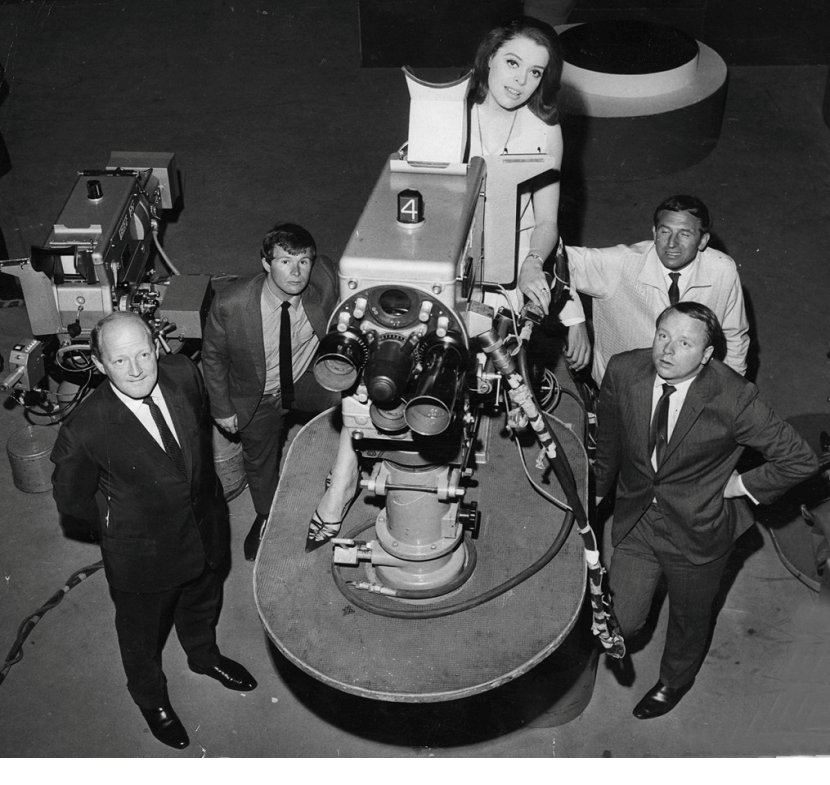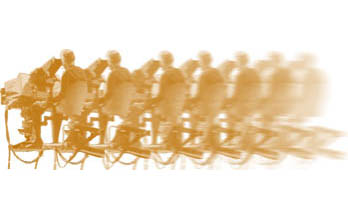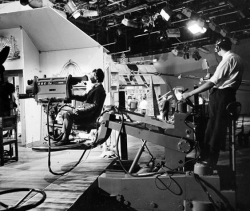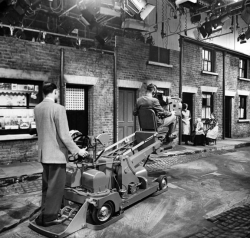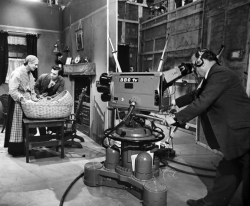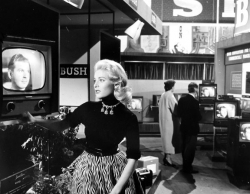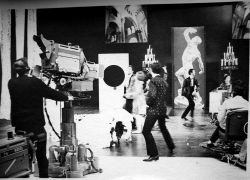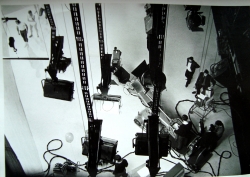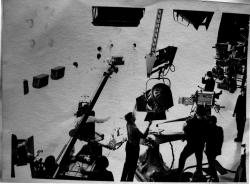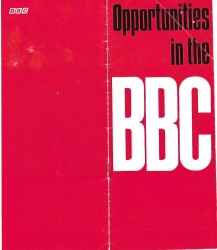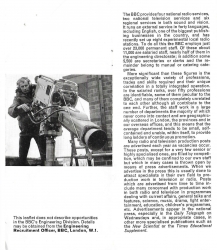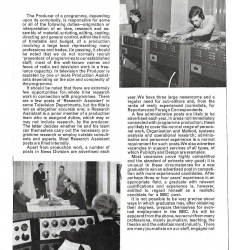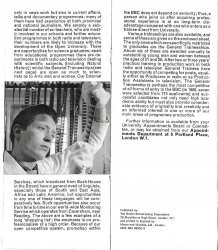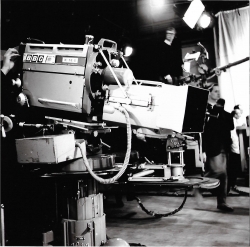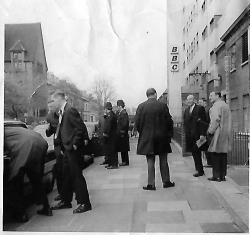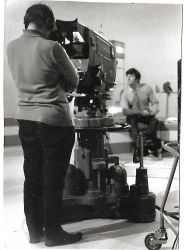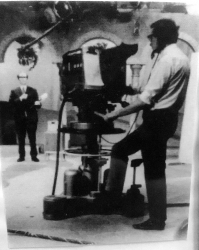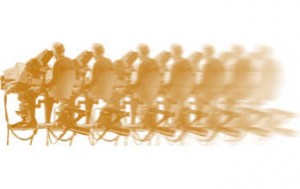In a leading article on Thursday 10th August 2017, the “Guardian” noted that this August was a month of anniversaries: a hundred years since the start of the battle of Passchendaele in the First World War, and seventy years since the partition of India in the years following the Second World War. In both cases, the unfolding on these historic events has been illustrated by the voices of people. The “Guardian” comments:
“… the collection of the reminiscences of ordinary people as a valued part of the story of a time or an event told from the perspective of those who were caught up in it rather than from the view of the elite that orchestrated it …to tell the story of history from below, a way of uncovering a radical message about power and agency… Oral history crosses the boundaries of both archive and voice to become something new again: a cultural instrument…”
Bernie started this site when he found photos from the nineteen-sixties/ nineteen-seventies and wanted to share them. Bernie thought that there might be others out there with pictures and stories that they too could share: and so here we are, with another collection of conversations, stories and pictures which together try to give an impression of what it was like to live through and work on the golden age of television in the BBC: it’s bottom up, it’s about what we did and thought and said – it is our history of BBC Technical Operations.
And so we have …
++++++++++++++++++++++++++++
6 days – The siege of the Iranian Embassy – Film
Tech Ops were asked a good time back to help with a film about the Iranian embassy siege in 1980. People who were there at the embassy helped out with technical info about trucks and cameras etc. The film has now been released.
This is an update to the previous conversations about the Iranian Embassy siege.
What people said…
++++++++++++++++++++++++++++
36 volt Power Pack
Dave Mundy was surprised to see a whole lot of IC circuitry within the 36 volt lithium-ion power pack for his extendable hedge cutter and chainsaw. he wondered if anyone could tell him what that is all about.
What people said…
++++++++++++++++++++++++++++
1951 OB Vehicles and Crew – an Update
OB stalwart (John Cox, DSS, Type 5 Unit 3) has recently joined the Tech Ops mailing list, and has been able to provide some nore information about the 1951 OB vehicles and crew in a picture.
What people said…
++++++++++++++++++++++++++++
ADAPT Live
And yet another update! An update to previous conversations about the ADAPT project.
Tech Ops people have worked with the ADAPT project in the past, and now veteran crews and kit have been reunited and filmed for Royal Holloway’s ADAPT project, which researches the history of television.
ADAPT attempts to show the public how Television was done in those early days.
What people said…
++++++++++++++++++++++++++++
Aerials – or Masts
Who’d be a rigger 1500 feet up a TV Tower?
Amongst other stories, John Cox tells us about his most dangerous rig at RAF Barkway near Royston in 1955.
What people said…
++++++++++++++++++++++++++++
Allocations Office 1975-ish
Simon Vaughan of the Alexandra Palace Television Society (APTS) has passed on a picture from Norman Taylor’s effects. The sheets they are working on look like allocations schedules, rather than anything production related, but was Tech Ops Allocations Office laid out like that?
What people said…
++++++++++++++++++++++++++++
Audio Fairs
The subject of “Audio Fairs” was mentioned during this period. Dave Mundy offered a snippet of one of the most popular demo sound-tracks used at these fairs.
What people said…
++++++++++++++++++++++++++++
Back in Time for …
The BBC have run a couple of interesting series (2016 – 2017), “Back in Time for Dinner”, in which a family had to sample the food that a typical family would have eaten through the years from 1900 to the end of that century.
Not to be outdone, we go back in time …
What people said…
++++++++++++++++++++++++++++
BBC Club at Lime Grove Studios
Caesar Glebbeek (lives in small old village surrounded by green hills, called Popiglio, in Tuscany) is writing an article about Jimi Hendrix’ appearances on BBC-TV – particularly TOTP – and has asked some of us some questions about staging, sound set up and so on. As part of this, he asked about the BBC Club at Lime Grove as, apparently, the bass player Noel Redding went to that bar a few times during various TOTP shows.
What people said…
++++++++++++++++++++++++++++
BBC News At 10 21st Jun 2017
The Newsroom automation crashed 45 seconds to 22:00.
If you were watching on the News Channel you just saw seemingly random bits of footage followed by Huw sitting there twiddling his thumbs for several minutes. A reboot afterwards fixed it.
What people said…
++++++++++++++++++++++++++++
BBC Pay Grades – 1966
Geoff Fletcher went back through his 1966 Diary notes to provide a list of the BBC pay grades at that time – and the progress of one Technical Operator whose main interest was in vision.
What people said…
++++++++++++++++++++++++++++
Behind the Scenes: “The Frost Report” 1966
A very amateurish look – all zooming and crappy framing and poor exposure – at behind the scenes at “The Frost Report”.
What people said…
++++++++++++++++++++++++++++
Bells and Whistles
A conversation about bells, bells, ringers and clappers …
What people said…
++++++++++++++++++++++++++++
Bush House
Mike Jordan went along to have a look at Bush House when limited public access was granted at the southern end (which used to have the BBC shop), and he looked at the special display about the former BBC presence there.
What Mike Jordan said…
++++++++++++++++++++++++++++
Churchill’s 90th Birthday and a Noel Coward Programme
Noel Coward introduced a programme to mark Winston Churchill’s ninetieth birthday – “Ninety Years On” – and there was also “The Coward Review” made around a similar time. Who appeared on which show, and who worked on which show?
What people said…
++++++++++++++++++++++++++++
Country Pursuits
Rather like a country ramble, this wanders around a few topics very loosely concerned with country pursuits.
What people said…
++++++++++++++++++++++++++++
DAB, GTS and segue to Jack Sudic
What happens with the Greenwich Time Signal when the we’ve all gone over to Digital Audio Broadcasting? Will we all be three seconds out? What about the Big Ben Bongs?
Somehow this led on to stories about Jack Sudic.
What people said…
++++++++++++++++++++++++++++
Dirty Work
Dave Mundy remembered the joy (!) of “Gardener’s World” near Rutland Water. The riggers had to clean all the cables before putting them back on the cable reels.
This of course led on to other tales of dirty work – including “Police 5”
What people said…
++++++++++++++++++++++++++++
Do What You’re Told
Discussion around the ABS “Work to rule” which started on Wednesday 22 March 1967. The main aim of the “Work to rule” was to point out to management that Tech Ops – and sound and camera ops in particular – made their own contribution to programmes.
What people said…
++++++++++++++++++++++++++++
Do you recognise this vehicle?
A strange vehicle in BBC OB Colours of the nineteen-sixties has been making the rounds of the veteran and vintage vehicle circuit.
Hopefully Tech Ops have provided more information about it.
Noddy bikes feature, too.
What people said…
++++++++++++++++++++++++++++
Doctor Who? Who’s Future, Who’s Past …
There was some discussion about who the new Doctor Who might be, before it was revealed to be Jodi Whittaker.
And Tom Baker is to reprise his role to complete an episode.
So the timeline of the conversation may be a little disjointed: but, hey, it’s “Doctor Who”, we can go back and forth through time …
What people said…
++++++++++++++++++++++++++++
Doctor Who and the Mystery Men
In the mid-1970s, a handful of “Doctor Who”’s had their exterior work done via OB rather than the usual film unit. One of these was for Tom Baker’s opening series as the Doctor.An unused picture that appears on the stills 35mm contact sheet seems to show a man standing by one of the rocks with what appears to be a cine camera to his eye.
Any ideas?
What people said…
++++++++++++++++++++++++++++
Drumbeat
Hugh Sheppard remembers an episode of “Drumbeat”.
What people said…
++++++++++++++++++++++++++++
Early Cop Shows
- “Colonel March of Scotland Yard”
- “Fabian of the Yard”
- “No Hiding Place”
… the cars they drove around in …
… and how to receive and record these shows.
What people said…
++++++++++++++++++++++++++++
Family Bibles
Genealogy before the days of the Internet …
What people said…
++++++++++++++++++++++++++++
Flippin’ Shots
This is really a continuation of What Are We Doing?
Shots reversed in time (we’ve also discussed that before, see Travelling Backwards), shots mirrored L to R …
What people said…
++++++++++++++++++++++++++++
Fly Leads and Screening
Information about aerial downleads, and their associated plugs: examples of interference caused by unscreened aeriel fly-leads, and the remedy.
What people said…
++++++++++++++++++++++++++++
Freeview and High Pressure disruption
Freeview has said that high air pressure is the cause of disruption experienced during the Autumn by some of its users in England and Wales, and reported that it was unable to remedy the problem until weather conditions changed. Freeview said that the situation was “uncommon but unpredictable”.
What people said…
++++++++++++++++++++++++++++
Golf – and Hoists
More pictures and stories about camera hoists.
What people said…
++++++++++++++++++++++++++++
Gram Ops
Some more information to add to previous conversations about the position of Gram OPs being re-assessed for an upgrade.
What people said…
++++++++++++++++++++++++++++
Grams Library Omission
An atmosphere recording missing from the grams library. Volunteers may be needed to rectify this omission.
What people said…
++++++++++++++++++++++++++++
Grams and Tape Stories
A favourite Grams story – and a reminder of an unfavourite grams story
What people said…
++++++++++++++++++++++++++++
Guinness
Fond recollections …
What people said…
++++++++++++++++++++++++++++
How to check your Video Bandwidth
With all-day broadcasting, it is difficult to get a suitable picture to set up your video equipment. This beats the Test Card any day.
What people said…
++++++++++++++++++++++++++++
Jazz on TV 1960 -1969
Nicolas Pillai is keen to interview anyone who worked on BBC programmes that featured jazz between 1960 to 1969. Here are some of our recollections.
What people said…
++++++++++++++++++++++++++++
Jobsworths
Jobsworths? At the BBC? More tales …
What people said…
++++++++++++++++++++++++++++
John Wilson Prom 35
This prom was advertised as’semi-staged’, but more like nearly fully staged, as the orchestra barely featured.
Good sound balance, though, but there were earpiece/cheek mics.
Actually, there were three ex-BBC sound supervisors in a Grand Tier box at the Matinée performance of the John Wilson Prom of “Oklahoma” who thought it was excellent in every aspect!
What people said…
++++++++++++++++++++++++++++
Light Diffuser
One of our number wants to eliminate the reflections he gets off his office keyboard from a ceiling downlighter, and off dinner plates in the kitchen, from a spot mounting. Moving the lamps is not an option.
Some solutions are discussed.
What people said…
++++++++++++++++++++++++++++
Lost Course (and Show) Photographs
The corridors of Wood Norton Hall used to be festooned with course photos. Wwhat happened to them, are they accessible? Or have they joined the lost episodes of “Dr Who etc?”
What people said…
++++++++++++++++++++++++++++
Loudspeaker LS3/5A
A discussion on the merits of the >Loudspeaker LS3/5A: comparison with other speakers.
Some information and discussion about High FLAC fidelity.
What people said…
++++++++++++++++++++++++++++
Managemental Gobbledespeak
Don’t you love the way the BBC can come up with pompous sounding phrases?
What people said…
++++++++++++++++++++++++++++
Michael (Mike) Bond
A much-loved and respected Senior Cameraman …
… who just happened to be the author of the “Paddington Bear” books.
What people said…
++++++++++++++++++++++++++++
Miracle!
This started life as an “off-topic” discussion, developed into theology and history, discussed the origins and developments of Henry Lincoln’s theories about the Sang Real and the Merovingian Kings of France and the bloodline of Mary Magdalene, then covered Quantum theory and whether or not you can speak Vesuvian.
What people said…
++++++++++++++++++++++++++++
Mobile Phone Cameras – and DSLRs
For even the most dedicated cameramen, their SmartPhone indeed replaced the expensive (and bulky!) DSLR kit.
The Smartphone’s camera system is amazing- it can include zoom capability, differential and spot focussing, and spot exposure.
DSLRs on an auto setting are not fool-proof: colour can change quite perceptible between shots.
What people said…
++++++++++++++++++++++++++++
More Personalities – The Crew – 4
Including:
- Chick Anthony
- Buster Cole
- Otis Eddy
What people said…
++++++++++++++++++++++++++++
More Personalities – The Talent – 4
Including:
- Roger Moore
- Dusty Springfield
- Roy Dotrice
- Tony Booth
- Brian Cant
What people said…
++++++++++++++++++++++++++++
Morecombe and Wise Scene
On Facebook, Bernie found a really bad lift of a bad, short, VHS recording of a schools programme looking behind the scenes at a Morecambe and Wise rehearsal.
What people said…
++++++++++++++++++++++++++++
Mugs
Roger Bunce discovered a company that was breaking copyright by marketing mugs bearing images from “Cameraman: the Movie”.
What people said…
++++++++++++++++++++++++++++
Mushrooms
Field mushrooms – safe and good to eat. White cap and pink gills – that is a pretty good guide.
But beware of similar looking fungi.
What people said…
++++++++++++++++++++++++++++
Music in TV and Radio Productions
More discussion about the intrusiveness of unwanted music in dramas.
What people said…
++++++++++++++++++++++++++++
Network Feeds
“Dad’s Army” on Saturday night on BBC2 Scotland (via Sky) was being shown in the correct aspect ratio. But on BBC2 England, the picture was wide screen.
BBC2 Scotland seem to opt-in/out of the network feed before junctions as there is a distinct sound break before and after junctions.
What people said…
++++++++++++++++++++++++++++
Nostalgia … Ah! Childhood…
Roger Bunce and Bernie Newnham visited the SciFi exhibition at the Barbican.
The exhibition was mostly concerned with Sci-Fi artwork, movie props, and clips.
What people said…
++++++++++++++++++++++++++++
Oh to be in OBs
Reminiscences of working with the Research Dept.’s HDTV OB truck, including a visit to a Trade Exhibition to supply pictures for Philips HDTV CRTs in Central London. It was an excellent day by the time all the drinks had been consumed!
And OBs at TVC – with the odd Jobsworth …
What people said…
++++++++++++++++++++++++++++
OLED TV
OLED pictures are beautiful given good source material.
What people said…
++++++++++++++++++++++++++++
Our Friend Victoria
Reminiscences of working on various programmes starring Victoria Wood.
What people said…
++++++++++++++++++++++++++++
Paid For TVs
Some people used to get a rental television. There were other perks, too.
Who got what?
What people said…
++++++++++++++++++++++++++++
Photos
George Auckland has forwarded some rather splendid photographs from the golden age of studio-based, theatrical style drama productions. The owner thinks they were shot at Ealing Studios – which they clearly weren’t!
Tony Crake found some interesting prints squashed in the bottom of a large box of 1960s’ B&W pictures.
What people said…
++++++++++++++++++++++++++++
Programmes May to November 2017
A discussion of the technical issues and programme content of some of the programmes over the last six months or so. Some programmes have a page in their own right: in this section, we discuss:
- The Eurovision Song Contest
- Doctor Who
- Sgt Pepper’s Musical Revolution with Howard Goodall
- Election Night Special 08 June 2017
- Casualty Saturday 29 July 2017
- Rock Goes to College
- Newsnight – Technical Issues
- Harry and Megan Interview
What people said…
++++++++++++++++++++++++++++
Proms and Power, Sound and Fury
Loss of Transmission from the Proms – and general power outages –
and discussion of the sound coverage of the Proms 2017.
What people said…
++++++++++++++++++++++++++++
Paul Temple and Dick Barton
Paul Temple and Dick Barton – and Michael Bentine, too…
What people said…
++++++++++++++++++++++++++++
Radio on iPlayer
The BBC have taken the radio channels off iPlayer, and so now you have to get a separate iPlayer Radio app .
What people said…
++++++++++++++++++++++++++++
Recent Animations
- Five go on a Great Westrn Adventure (advert)
- Loving Vincent (feature film)
What people said…
++++++++++++++++++++++++++++
Recent Feature Films
What people said…
++++++++++++++++++++++++++++
Rising Mics
Some tales associated with rising mics.
What people said…
++++++++++++++++++++++++++++
Riverside Studios – an Update
The Hammersmith Society newsletter update contained a piece about the redevelopment of the old Riverside Studios to include theatre and TV studio spaces, a cinema with dedicated foyer and screening room, a main foyer and atrium area, restaurant, café brasserie and bakery, and lots more …
What Keith Wicks said…
++++++++++++++++++++++++++++
Ronnie Pantlin Stories
There must be hundreds of Ronnie Pantlin stories!
Here are a few…
The tales people told …
++++++++++++++++++++++++++++
Scripts on EBay
- Doctor Who
- The Liver Birds
What people said …
++++++++++++++++++++++++++++
Secrets of the Super Elements
A documentary shot entirely on Smartphones? Why? The reason is that Smartphones use many of the properties of the superelements discussed in the programme, so it seemed a natural fit to use Smartphones to record the programme.
Resolution of a 405 line Image Orthicon: 503 (horizontal res) × 377 (effective vertical lines) = 189631 bytes, although this is analogue, so the horizontal resolution is not quite defined in terms of pixels.
Resolution of modern Smartphones = 16 Mb.
What people said…
++++++++++++++++++++++++++++
Sequels and Prequels: BladeRunner and Star Trek
A sequel to “Bladerunner” in the cinema – and a prequel (series) to “Star Trek” on Netflix.
Treats for the sci-fi fans.
What people said…
++++++++++++++++++++++++++++
Simulcast – except Sound
The “live” to cinema shows (such as Simulcast Opera) are fraught with problems, and unfortunately there is never anyone available in the cinemas to sort things out if there is a problem.
What people said …
++++++++++++++++++++++++++++
Sky – Believe in …?
What programmes on Sky are worth watching?
Benefits (or not) of Sky versus other broadband and content providers.
Sky News possible shut-down.
What people said …
++++++++++++++++++++++++++++
Small Cameras
Small cameras and some programmes made using them – “Flying Scotsman” and “Saving Lives at Sea”.
What people said …
++++++++++++++++++++++++++++
Snape, Acoustics, Filter, Sound
A discussion which started with Snape Maltings and the Snape Proms, but continued then to cover acoustics of various venues, sound filtering and finishing with AGC on a failing sound circuit for news.
What people said …
++++++++++++++++++++++++++++
Sole-schism
A pair of shoes that fell apart – a story shared but surely off-topic? But, no, there were some Tech Ops stories associated with this.
What people said …
++++++++++++++++++++++++++++
Sound Management
The management of the people who were on the Sound side of Tech Ops, including SSs and Gram Ops – and (a bowdlerised version of) what those people thought of the management.
What people said …
++++++++++++++++++++++++++++
Sound? You’re having a laugh!
The lighter side of the Sound side of Tech Ops…
What people said …
++++++++++++++++++++++++++++
Space – the Final Frontier?
Not So final as it used to be. After a skirmish with Aliens, people reported what they were doing when Apollo 11 touched down on the Moon.
The space probe Cassini smashed into Saturn on 15th September 2017, after some 20 years in space (travel and orbit). 20 years ago most of us didn’t have a PC!
What people said…
++++++++++++++++++++++++++++
Studio-based Continuing Drama Production Development
A promo for “Coronation Street” purports to show the development of studio techniques in the production of the studio-based continuing drama – er, “soap”.
What people said …
++++++++++++++++++++++++++++
Tech Ops OB Crew List 1959
John Cox found a crew list for OBs from 1959, but couldn’t find the pencil that he lent to HM the Queen.
What people said …
++++++++++++++++++++++++++++
Tech Ops Staff List – 01 May 1962
The complete Tech Ops Staff list for 1st May 1962.
What people said …
++++++++++++++++++++++++++++
Tech Ops Staff List – 29 September 1965
The complete Tech Ops Staff list for 29th September 1965.
What people said …
++++++++++++++++++++++++++++
That’s not what happened during Rehearsal!
A couple of stories about things being different on Transmission: and a mic story.
What people said …
++++++++++++++++++++++++++++
The Box of Delights
A photo behind the scenes on “The Box of Delights”.
What people said …
++++++++++++++++++++++++++++
The Good Old Days
Questions about the programme “The Good Old Days” and stories of BBC Leeds.
What people said …
++++++++++++++++++++++++++++
They Made Us What We Are Today
A look at some of the children’s comics that were around when we were growing up, and a look at some content, too.
Which led on to fader cleaning – for which the best solution was ‘nose grease’.
What people said …
++++++++++++++++++++++++++++
TV Studio Fulham Broadway
Were you ever approached with a sotto voce “Want to earn a little extra on your next day off?”?
A little bit of free-lancing – or was it moonlighting?
What people said …
++++++++++++++++++++++++++++
TVC -2017
TVC Studios 1, 2 and 3 return to use – but what are they used for?
What people said …
++++++++++++++++++++++++++++
Vanity Plates
Registration numbers we have seen, have owned or have known about.
What people said …
++++++++++++++++++++++++++++
Vinyl LPs
A resurgence in Vinyl LP sales and a resurgence in their pricing.
What people said …
++++++++++++++++++++++++++++
VT Tea Mugs
Some info about the famous VT Tea Mugs.
What people said …
++++++++++++++++++++++++++++
What are We Doing?
It used to be simple: we went live on air on transmission or we telerecorded, usually to videotape but otherwise to film recording.
Nowadays, usage seems to be changing, especially in other branches of the media. Scenes or PTCs or Vox Pops are, apparent;y, “filmed” whether or not the cameras are “film” cameras or TV cameras – or what’s the difference? The sound and vision is likely to be stored on a memory card!
What people said…
++++++++++++++++++++++++++++
What is the Best Voice Recorder to Buy
What is the current flavour of the month for a small, battery powerable device which won’t break the bank.
What people said …
++++++++++++++++++++++++++++
What is the Best Radio to Buy
What is the current flavour of the month for a radio with good sound quality, with its own indoor aerial, preferably portable and capable of battery operation.
What people said …
++++++++++++++++++++++++++++
Yellow CSO
Discussion on the use of Yellow as the key colour for Colour Separation Overlay.
What people said …
++++++++++++++++++++++++++++
But there are more things than Tech Ops that we talked about!
Pat Heigham said: “… How brilliant is this forum! A bit like a virtual tea-bar, club, canteen at TVC! Chat about all sorts of things. Everyone might have an opinion/experience of lots of subjects – long may it continue…”
Of course, we must be careful not to be “ultracrepidarian “ – a new word found by Dave Mundy and which refers to someone who holds forth on a subject they know absolutely nothing about! So much more glamorous and a more up-market sounding word than ‘bullshitter’!
So here are some of the things that we have talked about, but are not part of Tech Ops history…
Sara Newman went out to dinner and met Floella Benjamin, 30 odd years after doing “PlaySchool”: she now sits in the House of Lords. She told Sara that she was angry because the Government had passed a law and the BBC was only compelled to make 4 hours of original children’s programmes. For a Public Broadcaster this is very bad. There is generally a great deal of unease about the amount of cartoons on TV and their content.
Pat Heigham and Hugh Sheppard met up with Jessica Escue, an American TV academic and producer, together with Tony Byers, Maggie Dale’s BBC pension scheme visitor. (Maggie Dale was the BBC’s pioneering ballet producer from the 1950s, who had died in 2010). They were interviewed on camera about working with Maggie and their fond personal memories. Retired designer Stuart Walker and Maggie’s sister, also ex-BBC, were there too, and they learned that Humphrey Burton and Edward Barnes had also contributed to a forthcoming documentary.

There was a long thread on repairing masonry: if the “wrong”(modern) mortar is used the freezing and thawing action ruins stone. ‘Professional builders’ have over the years done considerable damage by repointing soft brick and stone with cement mortar, and by using cement wash and synthetic wall paints on walls. Repair of a weathered and spalling stone normally requires a different type of lime that doesn’t remain as soft as a lime used within a mortar joint – the repaired stone needs to be hard enough to resist the elements and be as tough as the stone itself. When working with lime mortar / render it is usually advisable to include horse hair in the mix to bind it.
There were many suggestions about how to get rid of Jehovah’s Witnesses when they doorstep. If they turned up at the door with a small child, as they often do, Dave Mundy’s friend would say to the child ‘do you realise that if you get poorly and need a blood transfusion your Mummy and Daddy will let you die!’ Geoff Fletcher’s old school pal Tote had invented a new religion based on the works of Hank Jansan: one once occasion he discussed this with the poor JW who practically fought his way out of the front door laden with Hank Jansan paperbacks!
Dave Mundy had unwanted – spoof – emails, from, apparently “PayPal” and “DHL”. Pat Heigham’s usual response to unidentified phone calls is: ‘Stay on the line – this call is being traced and will be reported to Action Fraud UK – what is your number/name and from where are you calling’. What about TV Fox – an aerial that will pick up broadcast back-up of US cable channels so you can watch ANY channel free of charge, totally legal! Some were very suspicious. There will be more unwanted email if the Banks are to be allowed to give our data to other banks so that they can approach us with better offers. It’s a hare-brained scheme dreamt up by the regulator in the name of competition – they can’t understand why we’re not all switching our bank accounts every few months.
And then Dave Mundy reported that he had been ordered to switch on the central heating before October 1st. Is this the end of the world or is climate change real?
There was discussion on favourite kitchen utensils, following on from which Keith Wicks noted that the number of units of alcohol is easily calculated: it’s the volume in litres multiplied by the strength of the drink (alcohol by volume).
So a large (250 ml) glass of 15% abv wine would contain 0.25 x 15 = 3.75 units.
A small glass (175 ml) would contain 0.175 x 15 = 2.625 units.
Which was followed by discussion on the stuff you have to have for driving in France (for example, two breathalysers) – and it has to be IN the car (not the boot) as you’re supposed to put the jacket on before you get out of the car. – and how to change lamps when driving on the continent.
There was much debate about computer issues: for example, Windows 10 Creators Update was another topic. Bernie found a solution for there being no longer a DefaultPassword string value in the Registry. Windows XP is still being used, but Vista has problems. There was discussion of other operating systems: MAC OS for Apple machines, and there are many advantages in using Linux: Ubuntu’s desktop colour is good and the fonts are so clear as to be perfect for aging eyes – but no support from Canon. Then there’s Raspberry Pis running Raspian, and PC workstations running Linux Mint. And, of course, Android machines.
Scribus is a free publishing program for Windows, and Libre Office and Open Office are free. What about the prices for electronics: things are cheap.
There was lots to interest those interested in aircraft, including some information about the former Hawker aircraft factory, and for the naturalists: last year it was Bernie’s nest box camera: this year it’s Hedgehog moments from John Nottage.
The origins of the name “SPAM” were discussed, and the best ways of washing and drying hands in public spaces was considered
More technical issues covered wet painted studio floors (and the effects of animal excreta on them), an outing of Ex LO & MR Scanner North 3, and when the International Space Station will be passing overhead.
There was a discussion about the problems of antacid and indigestion, sparked by a comment about Brian Eno which led to Eno’s liver salts which seemed to be nothing more than sodium bicarbonate, sodium carbonate, and citric acid. Protein pump inhibitors such as Omeprazole, Lansoprazole and Esomeprazole are useful, but have different side effects on different individuals. For indigestion or other symptomatic relief Gaviscon is good.
Geoffrey Hawkes noted that with most people of a certain age, all discussion paths eventually lead to, “Oh, do you suffer from that? I’m on this or that for my problem. What do you take, and how much? And it does what to you as well…? Oh, that’s nasty…”
Bob Foley has been in hospital for various procedures (including a successful carotid endartectomy), and all his many Tech Ops friends join in wishing him a speedy recovery.
And on that sort of subject, Dave Mundy encouraged us to count our blessings.
And finally…
Some of you may find that your contributions look a little different to the original email: that’s the heavy hand of your editor … the style guide is “sort of” based on what your editor can remember of the Chicago Manual of Style. Roger says it better:
Roger Bunce
But – if you really want to know –
How many dots make a pause? Answer: three, with spaces between them . . . It’s a punctuation mark called the ellipsis. It may even have its own ASCII code. (Peter Neil and I are campaigning for the restoration of the interrobang and, personally, I want to introduce a question mark with a comma at the bottom, for questions that happen half-way through a sentence!)
To apostrophe or not to apostrophe. Normally, an apostrophe is only used when an abbreviation has missed out a letter or two (so tell your young friends that the word ‘innit’ should really be spelled ‘i’n’it’), or when something belongs to a noun (but not when it belongs to a pronoun. Thus, his, hers, its, yours and theirs are all apostrophe free). So, when it comes to numbers – “I’ve got a loverly bunch of 4033s.” (plural, no apostrophe) or “Where’s this 4033’s cable?” (belonging to, apostrophe). That’s the way we did it in the 1960s (no apostrophe). He belongs to the 1960s’ generation (belonging to, apostrophe).
I’ve never understood what it is about high street shop names. People always want to add an ‘s’. The shop that used to be called ‘F.W. Woolworth’, finally gave up the struggle and rebranded itself as ‘Woolworths’, because that’s what everyone called it anyway. But the chemist shop of Mr. Boot, has been called ‘Boots’ for as long as I can remember. I suppose you should use an apostrophe if there’s one on the sign (e.g. MacDonald’s) but not if there isn’t. But people also add a completely gratuitous ‘s’ to shops which don’t have one, e.g. Marks and Spencer(s), W.H. Smith(s) etc. Should these have an apostrophe? If you consider W.H. Smith(s) to be an abbreviation of “Mr. W.H. Smith’s shop”, then you could argue for an apostrophe. But I think the pedantic answer is – Don’t add an ‘s’ when there isn’t one! No one adds an ‘s’ to ‘Poundland’, probably because it doesn’t sound like anyone’s name.


